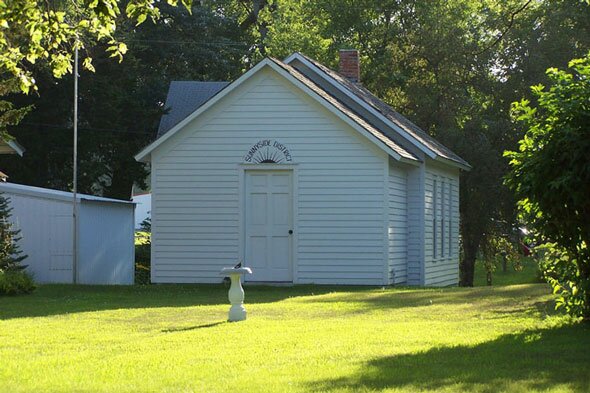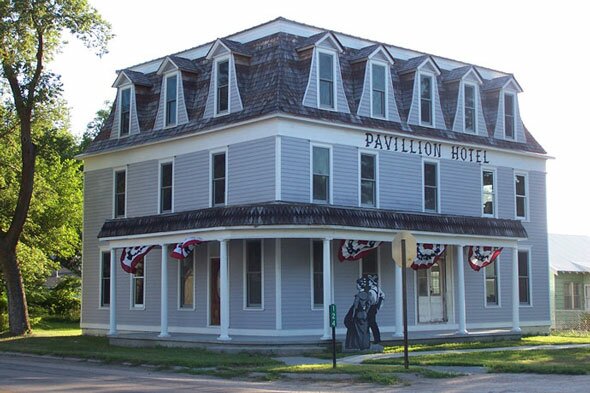Brief History of Loup County
(Excerpts taken from article by Mr. Kevin Brown published in Loup County Centennial Book 1883-1983).
Loup County was organized in 1883. The first white men settled here sometime prior to 1873 and lived a few miles southeast of Taylor in the Sioux Creek-Kent area. The first county seat was situated at Kent but was wrestled away by Taylor shortly after in 1883.
The population continued to grow as the homesteaders arrived, particularly following the Kinkaid Act of 1904...by 1930, however, census figures had dropped significantly and have continued in that pattern. Two rivers (the North Loup and the Calamus) and two highways (U.S. 183 and State Hwy 91) are vital to the county. Both rivers are scenic at all times of the year. The name "calamus" is a translation of the Dakota Indian name, Sinke-ta-wot (food for the muskrat) which was their name for the sweet flag of calamus plant growing along the river banks. The name may also be found in the Bible.
A K-12 accredited, county-wide school operates in Taylor. Redistricting was completed in 1971 and went into effect in the fall of '72. Before that, Loup County had had up to 42 operating school districts.
The village square at Taylor is distinctive, accentuated by ancient, shady cottonwoods in the central park. Most of the year the town is rather quiet, but when Loup County Fair time rolls around in Mid-August, the county seat becomes a whirlwind of activity.
Loup County is totally agriculture oriented, both in farming and ranching. Fine cattle of many breeds can be found at any number of large and small ranches. Loup County's Centennial was impressively observed in 1983....Some of the friendliest Nebraskans to be found in the state call Loup County home.
For more information contact the Loup County Historical Society.
Brief History of Taylor
(Excerpts taken from article by Floy Fletcher published in Loup County Centennial Book 1883-1983)
Joseph Rusho is sometimes referred to as the father of Taylor. It was on his land that he and his wife Josephine had purchased from Melissa Murry in 1881, that the original Town of Taylor was surveyed and platted in October 1883. We are told that Joseph Rusho felt "Rusho" or "Rushoville" would not seem a suitable name for this community so he had had it named "Taylor", for a homesteader friend, Edward H. Taylor.
After the establishment of the County seat in Taylor, Rusho provided temporary space in his home for court house purposes; later the Witt's store was utilized. On June 5 1884, Mr. Rusho offered the County Block 10 in the town site and $1,000 to be applied on the construction of a Courthouse...this building was used almost continuously until 1958.
In 1884 high school subjects were offered by the Taylor school but this school was not accredited until 1922. In 1905 the Bank of Taylor was organized and the present brick building built in 1914, and remodeled several times since. In 1917 the hitching chains and posts were removed from around the Public Square and moved to the side streets so cars could be parked there.
March 1, 1954 Rodeo Telephone Membership corporation was given a franchise to install telephone lines and telephones in the Village of Taylor. In the fall of 1963 the Town's sewer system was installed.
We are fortunate to have fire and ambulance services with trained personnal here in town, along with Region 26 for rapid communication.
For more information contact the Loup County Historical Society.
Museum and Historical Society
 The Loup County Historical Society was established in 1940. The society was responsible for the establishment of the Taylor museum about 1943. The museum is contained in three small buildings: the Pioneer Memorial Log Cabin, the former Taylor Clarion then public library building, and since 2002, the totally-renovated Sunnyside District #23 one-room schoolhouse. Many artifacts are housed in these small quarters.
The Loup County Historical Society was established in 1940. The society was responsible for the establishment of the Taylor museum about 1943. The museum is contained in three small buildings: the Pioneer Memorial Log Cabin, the former Taylor Clarion then public library building, and since 2002, the totally-renovated Sunnyside District #23 one-room schoolhouse. Many artifacts are housed in these small quarters. 
In 2011, the LCHS Taylor Museum and the Taylor Library partnered to purchase all Taylor Clarion newspaper microfilm dating back to 1893. The films have been a success with visitors looking for historical and genealogical information. You can view the microfilm at the Taylor Library on Monday, Wednesday and Fridays from 1-5 PM.
In 2012, the LC Historical Society aqcuired the old church located along HWY 183 as you come through town. The Society has already added several displays to view, many were in storage and now have a home. This is also the same location as the new Veterans Memorial.
The museum is open during county fair in August and during alumni weekend in October, plus open almost anytime by appointment.
Current officers include: Bob Christensen, president; Jolene Skalsky, vice president; Jean Harden, treasurer; and Roger Goos, secretary.
Admission is free, but donations are truly appreciated. For more information please contact Bob Christensen at (308) 750-5033 or email at or Jolene Skalsky at (308) 942-3496 or email at .
Pavillion Hotel

History: The Pavillion Hotel was built in 1887 by Heman and Mary Carter in anticipation of the railroad. The railroad never came to Taylor, but the Pavillion still stands as a reminder of the hopes and dreams of the little frontier town. The hotel was once known as the finest hostelry between Grand Island and Rapid City, South Dakota. In the late 1800's elegant meals were served on tables graced with real linen, silver, and crystal. The building has had 16 owners since it was built in 1887. Twelve of those ownerships took place before 1920. Loren and Marah Sandoz, the current owners, bought the building in January of 1996. Through the years the Pavillion has been remodeled several times and has had many different businesses in it. The old hotel has housed a newspaper office, a judge's office, a shoe store, a beauty salon, and a grocery store as well as being a hotel. The Pavillion was the social hub of the community. Taylor's hotel holds many legends and stories of happenings that took place within its walls. As the late Rose Schmidt wrote in 1987: "If old buildings could talk I am sure that the Pavillion would tell stories that would chill our blood and others that would make our heartstrings sing for joy for all the events that have taken place behind its walls during the past century." The Pavillion Hotel was entered in the National Register of Historic Places in 1987 and just recently (2010) the Pavillion was added to the list of "Hidden Treasures of Nebraska" which is a division of Heritage Nebraska. This group names “fading places” and “hidden treasures” as a way to highlight structures in need of preservation and to bring attention to less-publicized historic buildings--there is also the potential for more grants to help in the restoration process. You can read more here: http://www.omaha.com/article/20100521/NEWS01/705219881.
Future: The plans are to renovate the old hotel to its original beauty and function. On the first floor there will be an accessible bedroom, an office, a small gift shop, and a tea room/cafe. On the second floor there will be four spacious Victorian suites. On the third floor the old ballroom will be recreated for formal parties, banquets, meetings, and fine arts. Plans include an elevator to give full accessibility to the entire building.
Current Progress: The building has come a long way since it was purchased in 1996. The hotel now has a new roof, siding, windows, foundation, and insulation. Much work has been done to strengthen the floors and roof. The flooring on the third story is being put back along with wider stairs to the third floor that give better access to the ballroom. It has been a slow process that has started and stopped along with the finances available. If you would like more information about the Pavillion hotel please contact Marah or Loren Sandoz at 308-942-3148.




